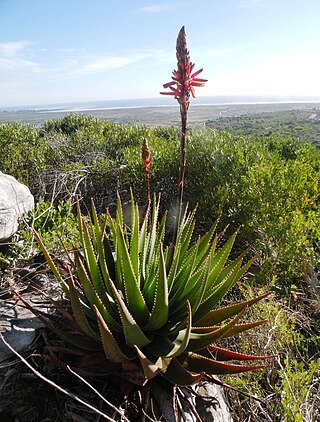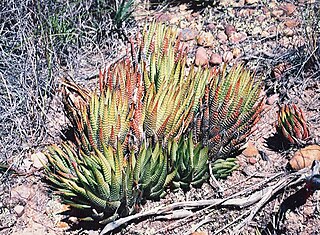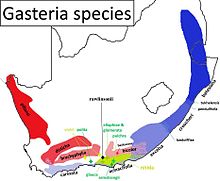
Fynbos is a small belt of natural shrubland or heathland vegetation located in the Western Cape and Eastern Cape provinces of South Africa. This area is predominantly coastal and mountainous, with a Mediterranean climate and rainy winters. The fynbos ecoregion is within the Mediterranean forests, woodlands, and scrub biome. In fields related to biogeography, fynbos is known for its exceptional degree of biodiversity and endemism, consisting of about 80% species of the Cape floral kingdom, where nearly 6,000 of them are endemic. This land continues to face severe human-caused threats, but due to the many economic uses of the fynbos, conservation efforts are being made to help restore it.

Gasteria is a genus of succulent plants, native to South Africa and the far south-west corner of Namibia.

Aloe succotrina, the Fynbos aloe, is an aloe which is endemic to Cape Town and the south-western corner of the Western Cape, South Africa.

Gasteria excelsa is a succulent plant, native to the Eastern Cape Province, South Africa.

Haworthiopsis fasciata, formerly Haworthia fasciata, is a species of succulent plant from the Eastern Cape Province, South Africa. The species is rare in cultivation; most plants that are labelled as H. fasciata are actually Haworthiopsis attenuata.

Gasteria armstrongii is a dwarf succulent plant native to South Africa, in the genus Gasteria.

Aloiampelos, formerly Aloe ser. Macrifoliae is a genus of succulent plants in the subfamily Asphodeloideae, comprising seven species found in Southern Africa. They are typically multi-branched climbing or sprawling shrubs, with long spindly stems and a large woody base on the ground. These characteristics, as well as their soft, narrow, triangular leaves whose lower part ensheathes the stem, make them easy to distinguish.

Aloe rupestris is an arborescent aloe indigenous to summer-rainfall areas of southern Africa.

Gasteria acinacifolia is succulent plant native to the Eastern Cape Province, South Africa.

Gasteria rawlinsonii is succulent plant of the genus Gasteria native to South Africa.

Gasteria pillansii is succulent plant native to the arid winter-rainfall regions in the far west of South Africa and Namibia.

Gasteria bicolor is a species of succulent flowering plant in the family Asphodelaceae, native to the Eastern Cape, South Africa.

Gasteria batesiana is a species of succulent plant, native to the inland escarpment in the far north-east of South Africa.

Gasteria carinata is a small and variable succulent plant, native to the Western Cape Province, South Africa.

Gasteria brachyphylla is succulent plant native to the Western Cape, South Africa.

Gasteria croucheri is a succulent plant, native to KwaZulu-Natal Province, South Africa.

Gasteria baylissiana, Suurberg gasteria, is a species of succulent flowering plant in the family Asphodelaceae, native to the Eastern Cape, South Africa.

Gasteria glauca, the Kouga gasteria, is a succulent plant, native to the cliffs above the Kouga river, in the Eastern Cape, South Africa.

Gasteria ellaphieae, or Ellaphie's gasteria, is a succulent plant, native to the cliffs above the Kouga dam, in the Eastern Cape, South Africa.

Gasteria polita, the polished gasteria, is a recently discovered succulent plant, restricted to a locality in the Afro-temperate forest of the Western Cape, South Africa.























